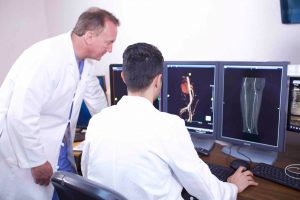Physical Examination
Since a varicocele cannot always be seen, a physical examination of your testicles in standing or lying positions may be required. If the physical exam proves to be ineffective in detecting the enlarged veins, then the doctor may have to perform a scrotal ultrasound in order to get a better look inside the scrotum. Typically by the time patients come to our office they have already been diagnosed with a varicocele.
Scrotal Ultrasound
Ultrasound uses high-frequency sound waves to create an image inside your body. Since the scrotum is located on the outside of the body this is an ideal test. What does the ultrasound look for? The ultrasound is done using a maneuver called “Valsalva.” The technologist may have you bear down like you’re going to the bathroom to see if the veins enlarge. If the veins meet a certain size criterion then the diagnosis of a varicocele can be made.1 Sometimes the abnormal flow can also be visualized. If you do not have an ultrasound our specialist will either order one at a location close to you or perform this study at our office; our doctor is dual board certified and can perform ultrasound studies himself.
CT Scan
A CT uses x-rays to look inside the body to provide detailed anatomy. Sometimes there can be other processes going on inside the abdomen that may block the flow in the testicular vein. The CT scan also performed to accurately measure the size of the testicular veins. Our specialist routinely orders this exam prior to treatment to allow for more precise placement of the coils to prevent migration or complication.
Request an Appointment
Please note that although we strive to protect and secure our online communications, and use the security measures detailed in our Privacy Policy to protect your information, no data transmitted over the Internet can be guaranteed to be completely secure and no security measures are perfect or impenetrable. If you would like to transmit sensitive information to us, please contact us, without including the sensitive information, to arrange a more secure means of communication. By submitting this form you consent to receive text messages from CVI at the number provided. Msg & data rates may apply. Msg frequency varies. Unsubscribe at any time by replying STOP.
What is Varicocele Embolization?
Varicocele can be treated by an embolization procedure or surgery. Embolization is a non-surgical, outpatient, minimally invasive technique that uses x-ray guidance to place tiny coils and embolic fluid in the abnormal blood vessels causing them to close down.
Am I a Candidate for Varicocele Embolization?
Treatment is offered for males who have:
- Fertility problems (problems fathering a child)
- Pain
- Boys with a smaller testicle; at a higher risk for fertility problems when they are older
How Is Non-Surgical Embolization Performed?
- You will receive twilight sedation to help you relax
- Our specialist numbs the skin on the neck or groin
- A tiny catheter is placed
- Foam and small coil plugs placed into the vein
- The catheter is removed
- Band-Aid is applied

We are Here to Help
Request an Appointment to meet with our varicocele specialist who will review your imaging, labs and history to determine if you are candidate for the procedure, and the outcomes you can expect. Each person is an individual and should discuss the potential risks and benefits of embolization and other treatments with our doctor to decide which option is best.
Appointments are available via an online video telehealth platform or in person at one of the offices in Los Angeles, Orange County or San Diego. Why should you choose us? Read here
1.) Cimador, M, Di Pace, M., Peritore, M., Sergio, M., Castagnetti, M., De Grazia, E. “The role of Doppler ultrasonography in determining the proper surgical approach to the management of varicocele in children and adolescents.” (2006). BJU Int. 97(6):p. 1291-1297.alth Care. Varicocele. https://stanfordhealthcare.org/medical-conditions/mens-health/varicocele.html
The above information explains what is involved and the possible risks. It is not meant to be a substitute for informed discussion between you and your doctor, but can act as a starting point for such a discussion.





